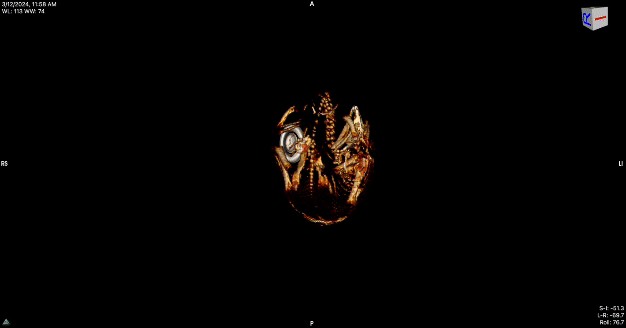Conservation
See 25 Astonishing Images From the World Press Photo Contest
The winning photographs capture moving moments in the midst of tumultuous global events
What Flaco the Owl’s Death Teaches Us About Making Cities Safer for Birds
Ornithologists and conservationists say humans can take key steps to make urban environments less hazardous for our avian friends
Peek Inside a California Condor Egg Just Before It Hatched, With This CT Scan of the Baby Bird
Last month, the San Diego Zoo Wildlife Alliance welcomed its 250th California condor chick in its breeding program, and the CT scan helped determine the bird was well-positioned for hatching
A Michigan Hunter Thought He Killed a Large Coyote. It Turned Out to Be an Endangered Gray Wolf
Wildlife officials believe the animal was likely the first gray wolf spotted in the southern Lower Peninsula in 100 years
Sea Otters Have Helped Bolster California’s Kelp Forest
A study that looks back more than 100 years shows that where the animals have thrived, underwater forests have, too
How Singapore Became an Unexpected Stronghold for a Critically Endangered Bird
Despite being the smallest country in Southeast Asia, the city-state is now home to the largest population of the straw-headed bulbul
To Save Sun Bears, Scientists First Have to Find Them
The world's smallest bear plays a crucial role in repairing its tropical habitat in Southeast Asia
How Rapa Nui Lost a Tree, Only to Have It Sprout Up Elsewhere
Before the toromiro disappeared from the island, at least two men grabbed seeds from the last remaining plant and brought them home
See the Portrait That Made Henry VIII Fall in Love With Anne of Cleves, Newly Restored to Its Former Glory
The Louvre cleaned and conserved Hans Holbein's 1539 likeness of the Tudor queen, revealing its vibrant colors and previously hidden details
Hundreds of Thousands of Salmon Die After Release in Northern California's Klamath River
The juvenile Chinook salmon likely died from pressure changes as they swam through an old tunnel in the Iron Gate Dam, slated to be removed this year as part of a massive demolition project
A Rare Gray Whale, Believed Extinct in the Atlantic for 200 Years, Has Been Spotted off New England
Scientists say a lack of Arctic sea ice due to climate change could have created a passageway for the mammal to travel from the Pacific Ocean
How Wasabi Can Help Preserve Ancient Papyrus
Researchers say the green horseradish-like paste can fight fungal infections without damaging fragile pigments
Single Orca Spotted Killing a Great White Shark for the First Time Ever
In less than two minutes, the marine mammal attacked a juvenile white shark and ripped out its liver in an encounter off the coast of South Africa last year
More Giant Pandas Are Coming to the U.S. in a New Loan From China
China plans to send a male and a female panda to the San Diego Zoo as early as this summer, and negotiations are underway for pandas' possible return to the National Zoo in Washington, D.C.
Fantastical Art Joins Hundreds of Blooming Orchids to Shed Light on Conservation Efforts
Smithsonian Gardens’ 28th annual orchid exhibition is underway at the Kogod Courtyard
The Case for Destroying Old Forest Roads
Can demolishing abandoned dirt paths point the way to a more sustainable future?
The Dugong, a Huggable, Seagrass-Loving Sea Cow, Has a New Best Friend: Drones
Keeping tabs on the species' populations is surprisingly hard. A new aerial effort tracks the marks they leave behind
Fifty Years After ‘Jaws,’ We’ve Learned a Lot About Great Whites
Though sport fishing tournaments and other activities led to population declines in the 1970s and 1980s, more recent science and conservation efforts have helped the sharks rebound
Hungry Sea Otters Help Prevent Erosion on California's Coast
The marine mammals, which were once hunted nearly to extinction, feed on crabs that would make the land more susceptible to erosion by digging holes in the soil and eating roots
This Camera Is Taking a 1,000-Year-Long Exposure Photo of Tucson's Desert Landscape
Jonathon Keats, who devised the plan, hopes the camera will inspire onlookers to contemplate how humanity’s actions affect the environment
Page 1 of 58
:focal(2000x1352:2001x1353)/https://tf-cmsv2-smithsonianmag-media.s3.amazonaws.com/filer_public/48/28/48280feb-2cea-40c4-85e5-c8f68c6b4c39/103_north_and_central_america_long-term_projects_alejandro_cegarra_the_new_york_times_bloomberg.jpg)
:focal(800x602:801x603)/https://tf-cmsv2-smithsonianmag-media.s3.amazonaws.com/filer_public/29/b1/29b1626f-700e-4c70-8191-1f1de83baf08/main_ci_lauren-oster_flacomemorial1.jpg)

:focal(519x346:520x347)/https://tf-cmsv2-smithsonianmag-media.s3.amazonaws.com/filer_public/13/c1/13c1722b-a85a-43dc-bc94-2d2cbb9bbcd6/download.png)
:focal(800x602:801x603)/https://tf-cmsv2-smithsonianmag-media.s3.amazonaws.com/filer_public/ae/15/ae155212-6160-4f05-889f-181d5ac44daa/gettyimages-1692828862_web.jpg)
:focal(800x602:801x603)/https://tf-cmsv2-smithsonianmag-media.s3.amazonaws.com/filer_public/24/f7/24f76caf-c8f2-4b3e-b5f1-931ec81bb4f4/shb_apr_final_web.jpg)
:focal(2416x1818:2417x1819)/https://tf-cmsv2-smithsonianmag-media.s3.amazonaws.com/filer_public/64/ac/64ace407-3b41-43d3-816a-b26e72920bee/img-611080-malaysian-sun-bear-malaysia-sebastian-kennerknecht.jpg)
:focal(800x602:801x603)/https://tf-cmsv2-smithsonianmag-media.s3.amazonaws.com/filer_public/71/39/7139c237-06f9-4013-b1d4-fee47c2f4832/sophora_toromiro_2c_web.jpg)
:focal(700x527:701x528)/https://tf-cmsv2-smithsonianmag-media.s3.amazonaws.com/filer_public/c9/df/c9df208e-a1f1-4e83-9485-ab4537f36a56/anne2.jpg)
:focal(400x244:401x245)/https://tf-cmsv2-smithsonianmag-media.s3.amazonaws.com/filer_public/5c/6d/5c6d6856-2d09-4536-a4bc-cbb78cc6b39b/fall-runchinook_web-gov.jpg)
:focal(3332x2507:3333x2508)/https://tf-cmsv2-smithsonianmag-media.s3.amazonaws.com/filer_public/4f/b1/4fb18b65-de2e-4762-ae42-0fb5303f6ce0/graywhale3_cropped.jpg)
:focal(2736x1824:2737x1825)/https://tf-cmsv2-smithsonianmag-media.s3.amazonaws.com/filer_public/db/55/db55f278-dc68-4a47-bd5f-6af9ff7de517/gettyimages-1230132238.jpg)
:focal(2550x1700:2551x1701)/https://tf-cmsv2-smithsonianmag-media.s3.amazonaws.com/filer_public/2a/0b/2a0b6c69-c2df-417e-b474-dab29dcc8fcd/gettyimages-639204074.jpg)
:focal(1520x1013:1521x1014)/https://tf-cmsv2-smithsonianmag-media.s3.amazonaws.com/filer_public/26/10/26108b49-7ac2-404f-ba63-72f63f0387f8/20050224-0124ab-newsroom.png)
:focal(1000x671:1001x672)/https://tf-cmsv2-smithsonianmag-media.s3.amazonaws.com/filer_public/82/02/8202f06c-db95-4927-9a8a-c23d62e85b91/phaan_with_orchid_sculptures_copy.jpg)
:focal(2826x1884:2827x1885)/https://tf-cmsv2-smithsonianmag-media.s3.amazonaws.com/filer_public/ed/e8/ede8c838-b9e7-40a7-8173-9f06b3fd1151/mar2024_h05_forestroaddeconstruction.jpg)
:focal(2688x2022:2689x2023)/https://tf-cmsv2-smithsonianmag-media.s3.amazonaws.com/filer_public/a9/48/a9486d72-2527-43f1-8fe2-7eeef50bb800/mar2024_b01_heroesofthewilddugong.jpg)
:focal(800x602:801x603)/https://tf-cmsv2-smithsonianmag-media.s3.amazonaws.com/filer_public/d6/3e/d63e43a8-8a82-4d29-a13c-0017d198a932/gettyimages-549035721_web.jpg)
:focal(726x429:727x430)/https://tf-cmsv2-smithsonianmag-media.s3.amazonaws.com/filer_public/ad/32/ad32752d-51c6-4814-b1c6-b2c382979a1d/gettyimages-563600441.jpg)
:focal(2000x1352:2001x1353)/https://tf-cmsv2-smithsonianmag-media.s3.amazonaws.com/filer_public/19/c7/19c7b63e-b1ed-4df2-8c5d-6321d141e08f/240110_millennium_camera_0005.jpg)